GMC SIERRA 1996 Owners Manual
Manufacturer: GMC, Model Year: 1996, Model line: SIERRA, Model: GMC SIERRA 1996Pages: 404, PDF Size: 21.57 MB
Page 201 of 404
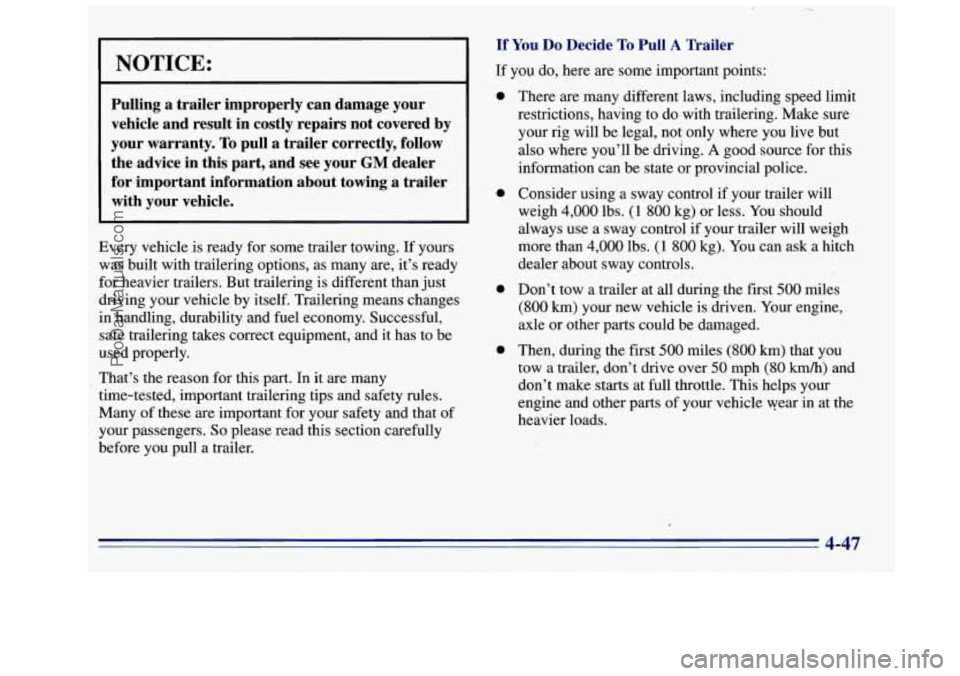
NOTICE:
Pulling a trailer improperly can damage your
vehicle and result in costly repairs not covered by
your warranty.
To pull a trailer correctly, follow
the advice in this part, and see your
GM dealer
for-important information about towing a trailer
with your vehicle.
Every vehicle is ready for some trailer towing. If yours
was built with trailering options, as many are, it’s ready
for heavier trailers. But trailering is different than just
driving your vehicle by itself. Trailering means changes
in handling, durability and fuel economy. Successful,
safe trailering takes correct equipment, and it has to be
used properly.
That’s the reason for this part. In it are many
time-tested, important trailering tips and safety rules.
Many of these
are important for your safety and that of
your passengers.
So please read this section carefully
before you pull
a trailer.
If You Do Decide To Pull A Trailer
If you do, here are some important points:
0
0
0
0
There are many different laws, including speed limit
restrictions, having to do with trailering. Make sure-
your rig will be lega1,not only where you live but
also where you’ll be driving. A good source for this
information can be state or provincial police.
Consider using a sway control if your trailer will
weigh
4,000 lbs. (1 800 kg) or less. You should
always use a sway control if your trailer will weigh
more than
4,000 lbs. (1 800 kg). You can ask a hitch
dealer about sway controls.
Don’t tow a trailer at all‘during the first
500 miles
(800 km) your new vehicle is driven. Your engine,
axle or other parts could be damaged.
Then; during the first
500 miles (800 km) that you
tow a trailer, don’t drive over
50 mph (80 ktn/h) and
don’t make starts at full throttle. This helps your
engine and other parts of your vehicle wear in at the
heavier loads.
4-47
ProCarManuals.com
Page 202 of 404
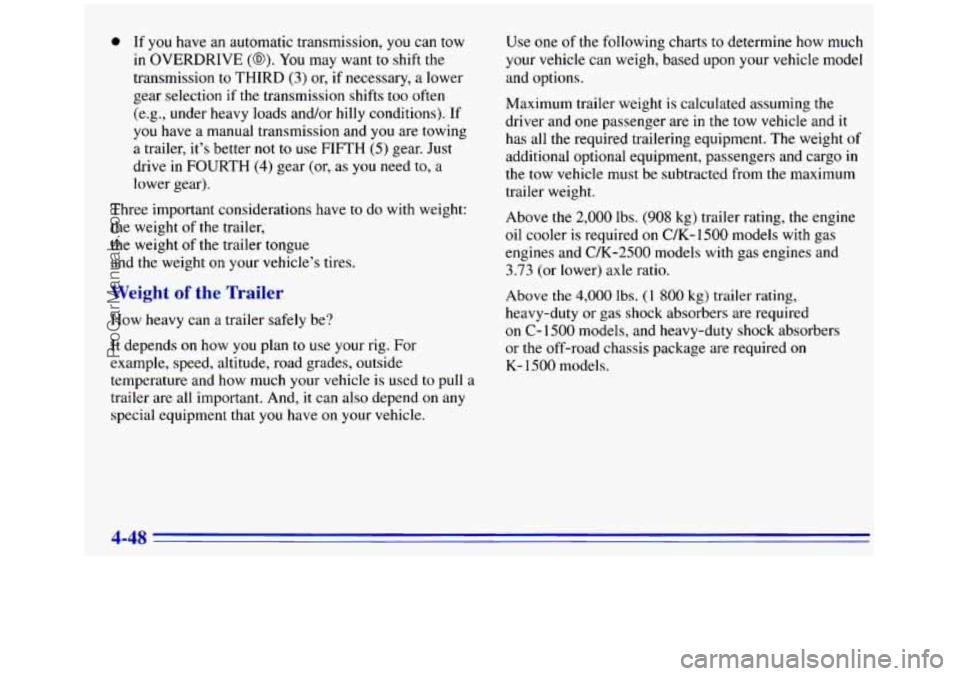
0 If you have an automatic transmission, you can tow
in OVERDRIVE
(@). You may want to shift the
transmission to THIRD (3) or, if necessary, a lower
gear selection if the transmission shifts too often
(eg, under heavy loads and/or hilly conditions). If
you have a manual transmission and you are towing
a trailer, it’s better
not to use FIFTH (5) gear. Just
drive in FOURTH
(4) gear (or, as you need to, a
lower gear).
Three important considerations have to do with weight:
the weight
of the trailer,
the weight
of the trailer tongue
and the weight
on your vehicle’s tires.
Weight of the Trailer
How heavy can a trailer safely be?
It depends on how
you plan to use your rig. For
example, speed, altitude, road grades, outside
temperature and how much your vehicle is used to pull
a
trailer are all important. And, it can also depend on any
special equipment that you have on your vehicle. Use
one
of the following charts to determine how much
your vehicle can weigh, based upon your vehicle model
and options.
Maximum trailer weight is calculated assuming the
driver and
one passenger are in the tow vehicle and it
has all the required trailering equipment. The weight
of
additional optional equipment, passengers and cargo in
the tow vehicle must be subtracted from the maximum
trailer weight.
Above
the 2,000 lbs. (908 kg) trailer rating, the engine
oil cooler is required
on C/K- 1500 models with gas
engines and
C/K-2500 models with gas engines and
3.73 (or lower) axle ratio.
Above
the 4,000 lbs. (1 800 kg) trailer rating,
heavy-duty or gas shock absorbers are required
on
C- 1500 models, and heavy-duty shock absorbers
or
the off-road chassis package are required on
K-1500 models.
4-48
ProCarManuals.com
Page 203 of 404
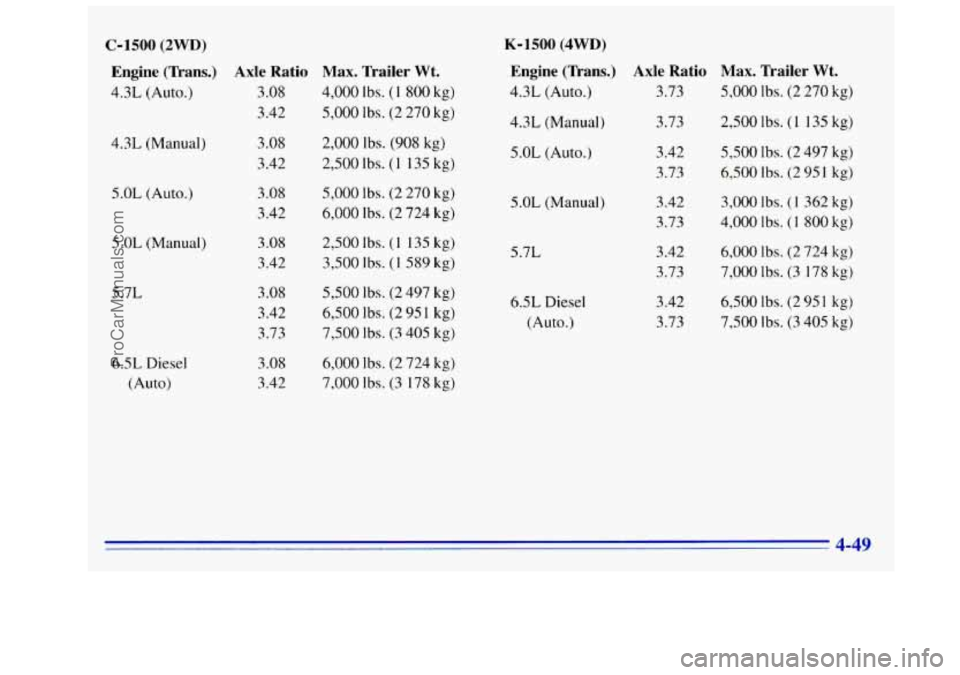
C-1500 (2WD)
Engine (Trans.)
Axle Ratio
4.3L (Auto.) 3 .os
3.42
4.3L
(Manual j
5.0L (Auto.)
5.0L (Manual)
5.7L
6.5L
Diesel
(Auto)
3 .os
3.42
3.08
3.42 3
.OS
3.42
3 .os
3.42
3.73
3.08
3.42
Max. Trailer Wt.
4,000 Ibs. (1 800 kg)
5,000 Ibs. (2 270 kg)
2,000 lbs. (908 kg)
2,500 lbs. (1 135 kg)
5,000 lbs. (2 270 kg)
6,000 Ibs. (2 724 kg)
2,500 Ibs. (1 135 kg)
3,500 Ibs. (1 589 kg)
5,500 lbs. (2 497 kg)
6,500 lbs. (2 95 1 kg)
7,500 Ibs. (3 405 kg)
6,000 lbs. (2 724 kg)
7,000 lbs. (3 178
kg)
K-1500 (4WD)
Engine (Trans.)
Axle Ratio
4.3L (Auto.) 3.73
4.3L
(Manual)
5.0L (Auto.)
5 .OL (Manual)
5.7L
6.5L
Diesel
(Auto.)
3.73
3.42
3.73
3.42
3.73
3.42
3.73
3.42
3.73
Max. Trailer Wt.
5,000 lbs. (2 270 kg)
2,500 lbs. (1 135 kg)
5,500 lbs. (2 497 kg)
6,500 Ibs. (2 951 kg)
3,000 Ibs. (1 362 kg)
4,000 I bs. ( 1 800 kg)
6,000
lbs. (2 724 kg)
7,000 lbs. (3 178 kg)
6,500 lbs. (2 95 1 kg)
7,500 Ibs. (3 405 kg)
ProCarManuals.com
Page 204 of 404
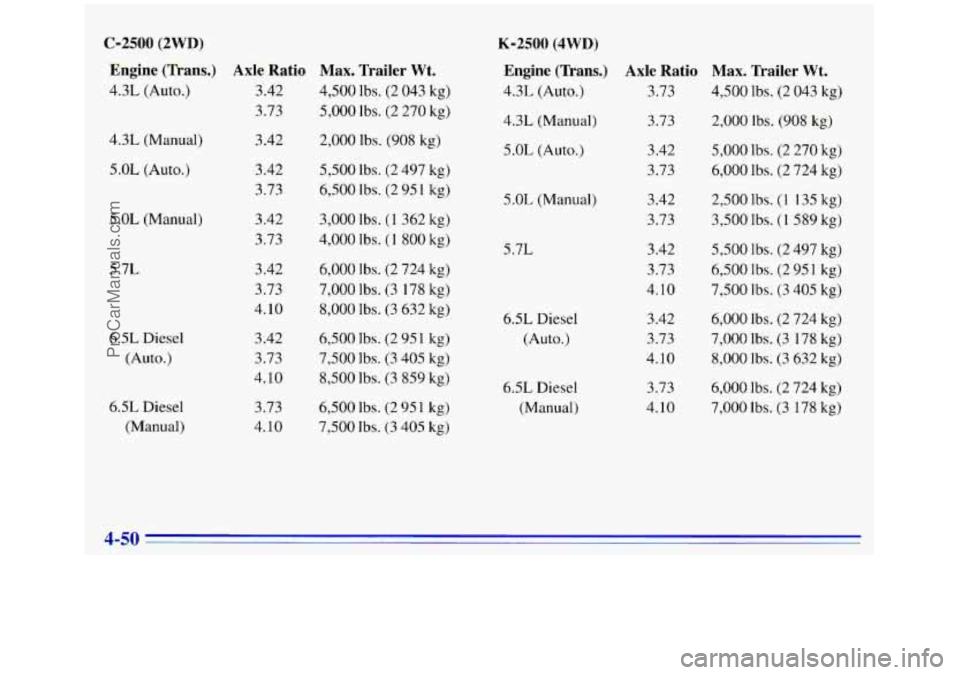
C-2500 (2WD) K-2500 (4WD)
Engine (Trans.) Axle Ratio
Max. Trailer Wt.
4.3L (Auto.) 3.42 4,500 lbs. (2 043 kg)
3.73
5,000 lbs. (2 270 kg)
Engine (Trans.) Axle Ratio Max. Trailer Wt.
4.3L (Auto.) 3.73 4,500 lbs. (2 043 kg)
4.3L (Manual) 3.73 2,000 lbs.
(908 kg)
4.3L (Manual)
5.0L (Auto.) 3.42
2,000 lbs. (908 kg) 5.0L (Auto.) 3.42
3.73 5,000 lbs. (2 270 kg)
6,000 lbs.
(2 724 kg)
3
-42 5,500 lbs. (2 497 kg)
3.73 6,500 lbs.
(2 951 kg) 5 .OL (Manual)
3.42
3.73 2,500 lbs. (1 135 kg)
3,500 lbs.
(1 589 kg) 5 .OL (Manual)
3.42 3,000 lbs. (1 362 kg)
3.73 4,000 lbs.
(1 800 kg)
5.7L 3.42
3.73
4.10 5,500 lbs. (2 497 kg)
6,500 lbs. (2 95
1 kg)
7,500 lbs. (3 405 kg)
5.7L 3.42 6,000 Ibs. (2 724 kg)
4.10
8,000 lbs. (3 632 kg)
3.73 7,000 lbs. (3 178 kg)
6.5L Diesel
(Auto.) 3.42
3.73
4.10 6,000
lbs. (2 724 kg)
7,000 lbs. (3 178 kg)
8,000 lbs. (3 632 kg)
6.5L Diesel
(Auto.) 3.42 6,500 lbs. (2 95 1 kg)
4.10
8,500 lbs. (3 859 kg)
3.73 7,500
lbs. (3 405 kg)
6.5L Diesel
(Manual) 3.73
4.10 6,000 lbs.
(2 724 kg)
7,000 lbs. (3 178 kg)
6.5L Diesel
(Manual) 3.73 6,500 lbs.
(2 95 1 kg)
4.10
7,500 Ibs. (3 405 kg)
ProCarManuals.com
Page 205 of 404
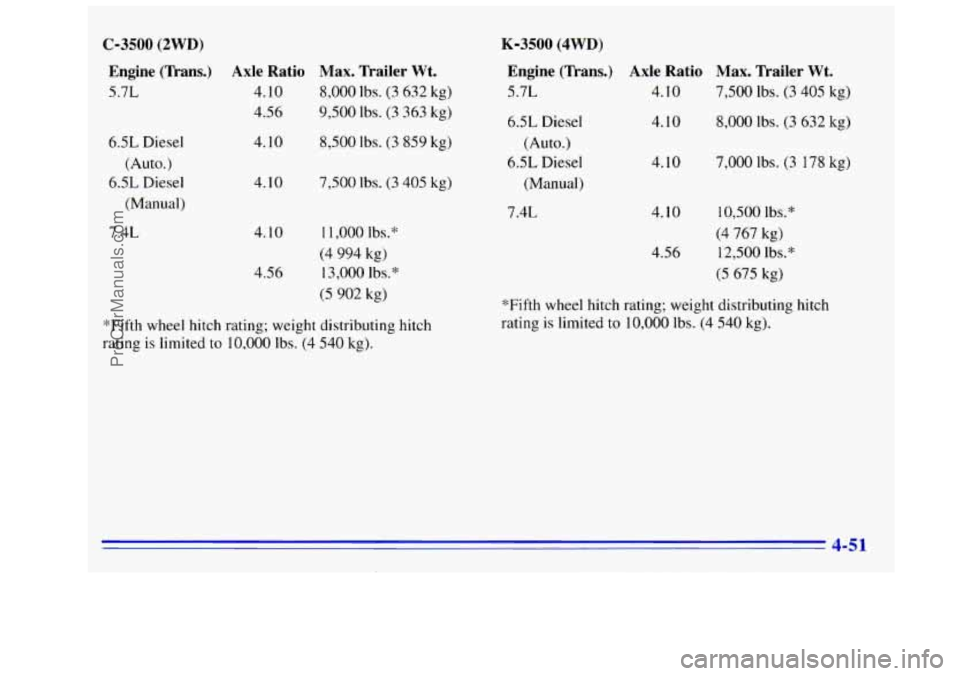
C-3500 (2WD)
Engine (Tkans.) Axle Ratio Max. Trailer Wt.
5.7L 4.10 8,000 lbs. (3 632 kg)
4.56 9,500 Ibs. (3 363 kg)
4.10
8,500 Ibs. (3 859 kg) 6.5L Diesel
(Auto.)
6.5L Diesel
(Manual)
7.4L 4.10
4.10
4.56 7,500 Ibs. (3 405 kg)
11,000 Ibs."
(4 994 kg)
13,000
Ibs.*
(5 902 kg)
*Fifth wheel
hitch rating; weight distributing hitch
rating
is limited to 10,000 lbs. (4 540 kg).
K-3500 (4WD)
Engine (lkans.) Axle Ratio Max. Trailer Wt.
5.7L 4.10 7,500 lbs. (3 405 kg)
6.5L Diesel
(Auto.)
6.5L Diesel
(Manual)
7.4L 4.10
4.10
4.10
4.56
8,000 lbs. (3 632 kg)
7,000 Ibs. (3 178 kg)
10,500 lbs.*
(4 767 kg)
12,500 lbs.*
(5 675 kg)
*Fifth wheel hitch rating; weight distributing hitch
rating is limited
to 10,000 lbs. (4 540 kg).
4-51
ProCarManuals.com
Page 206 of 404
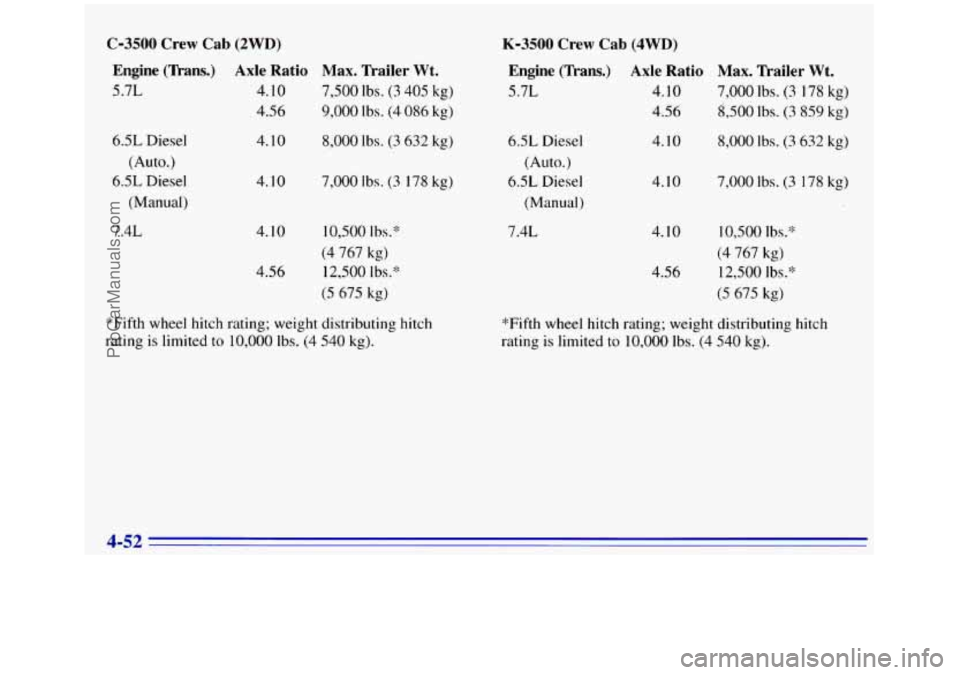
C-3500 Crew Cab (2WD)
Engine (Trans.) Axle Ratio Max. Trailer Wt.
5.7L 4.10 7,500 lbs. (3 405 kg)
4.56 9,000
Ibs. (4 086 kg)
6.5L Diesel
(Auto.)
6.5L Diesel
(Manual)
7.4L
4.10
4.10
4.10
4.56
8,000 lbs. (3 632 kg)
7,000
Ibs. (3 178 kg)
10,500 lbs.*
(4 767 kg)
12,500
Ibs.*
(5 675 kg)
*Fifth
wheel hitch rating.; weight distributing hitch
rating
is limited to 10,000 lbs. (4 540 kg).
K-3500 Crew Cab (4WD)
Engine (Tkans.) Axle Ratio Max. Trailer Wt.
5.7L 4.10 7,000 Ibs. (3 178 kg)
4.56 8,500
Ibs. (3 859 kg)
6% Diesel
(Auto.)
6.5L Diesel
(Manual)
7.4L 4.10
4.10
4.10
4.56
8,000 Ibs. (3 632 kg)
7,000
Ibs. (3 178 kg)
10,500
Ibs*
(4 767 kg)
12,500
Ibs?
(5 675 kg)
*Fifth wheel hitch rating; weight distributing hitch
rating
is limited to 10,000 Ibs. (4 540 kg).
4-52
ProCarManuals.com
Page 207 of 404
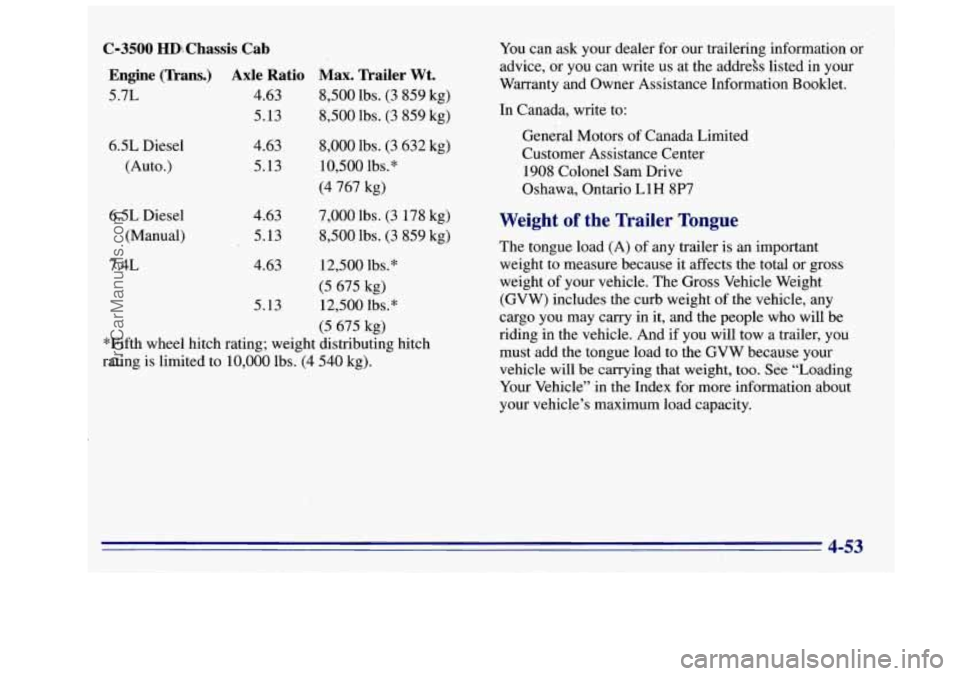
(2-3500 HDiChassis .Cab Engine (Trans.) Axle Ratio
Max. Trailer Wt.
5.7L 4.63 8,500 lbs. (3 859 kg)
5.13
8,500 lbs. (3 859 kg)
6% Diesel
(Auto.)
6.5L Diesel
(Manual)
7.4L 4.63
5.13
4.63 5.13
4.63
5.13
8,000 lbs. (3 632 kg)
10,500 lbs.*
(4 767 kg)
7,000 lbs. (3 178 kg)
8,500 lbs. (3 859 kg)
12,500 lbs.*
(5 675 kg)
12,500 lbs.*
(5 675 kg)
*Fifth wheel hitch rating; weight distributing hitch
rating is limited to 10,000 lbs. (4 540 kg). You
can ask your dealer for our trailering information or
advice, or you can write us at the addreis listed in your
Warranty and Owner Assistance Information Booklet.
In Canada, write to:
General Motors of Canada Limited
Customer Assistance Center
1908 Colonel Sam Drive
Oshawa, Ontario LlH 8P7
Weight of the Trailer Tongue
The tongue load (A) of any trailer is an important
weight to measure because it affects the total or gross
weight of your vehicle. The Gross Vehicle Weight
(GVW) includes the curb weight of the vehicle, any
cargo you may carry in it, and the people who will be
riding in the vehicle. And if you will tow a trailer, you
must add the tongue load to the GVW because your
vehicle will be carrying that weight, too. S&e “Loading
Your Vehicle” in the Index for more information about
your vehicle’s maximum load capacity.
4-53
ProCarManuals.com
Page 208 of 404
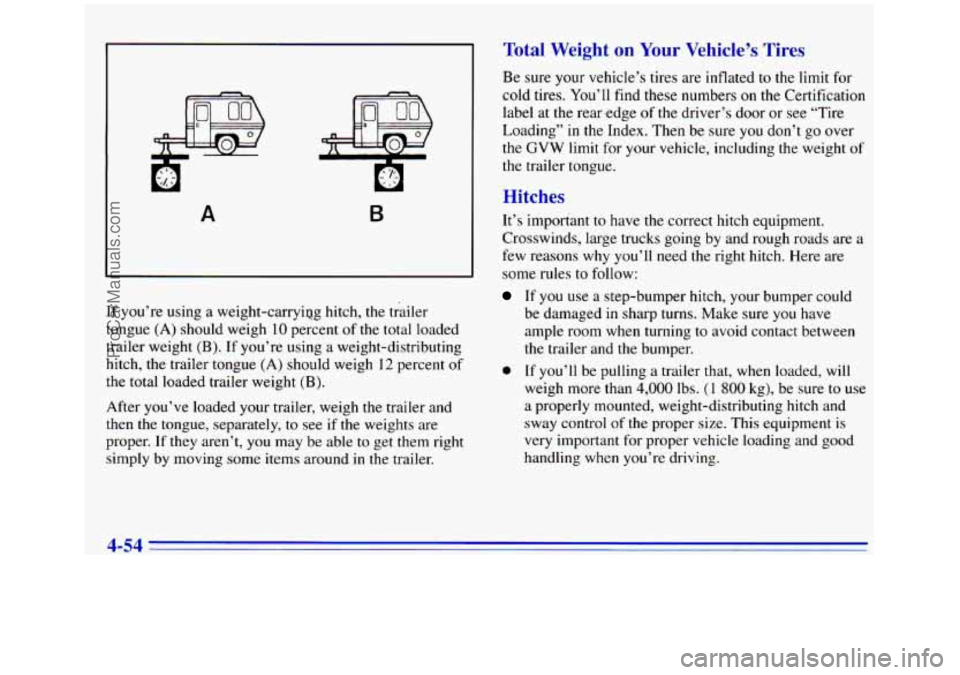
A B
If you’re using a weight-carryipg hitch, the trailer
tongue
(A) should weigh 10 percent of the total loaded
trailer weight
(B). If you’re using a weight-distributing
hitch, the trailer tongue
(A) should weigh 12 percent of
the total loaded trailer weight
(B).
After you’ve loaded your trailer, weigh the trailer and
then the tongue, separately,
to see if the weights are
proper.
If they aren’t, you may be able to get them right
simply
by moving some items around in the trailer.
Total Weight on Your Vehicle’s Tires
Be sure your vehicle’s tires are inflated to the limit for
cold tires.
You’ll find these numbers on the Certification
label at the rear edge
of the driver’s door or see “Tire
Loading” in the Index. Then be sure
you don’t go over
the
GVW limit for your vehicle, including the weight of
the trailer tongue.
Hitches
It’s important to have the correct hitch equipment.
Crosswinds, large trucks going by and rough roads are a
few reasons why you’ll need the right hitch. Here are
some rules
to follow:
If you use a step-bumper hitch, your bumper could
be damaged
in sharp turns. Make sure you have
ample room when turning
to avoid contact between
the trailer and the bumper.
0 If you’ll be pulling a trailer that, when loaded, will
weigh more than
4,000 Ibs. (1 800 kg), be sure to use
a properly mounted, weight-distributing hitch and
sway control
of the proper size. This equipment is
very important for proper vehicle loading and good
handling when you’re driving.
ProCarManuals.com
Page 209 of 404
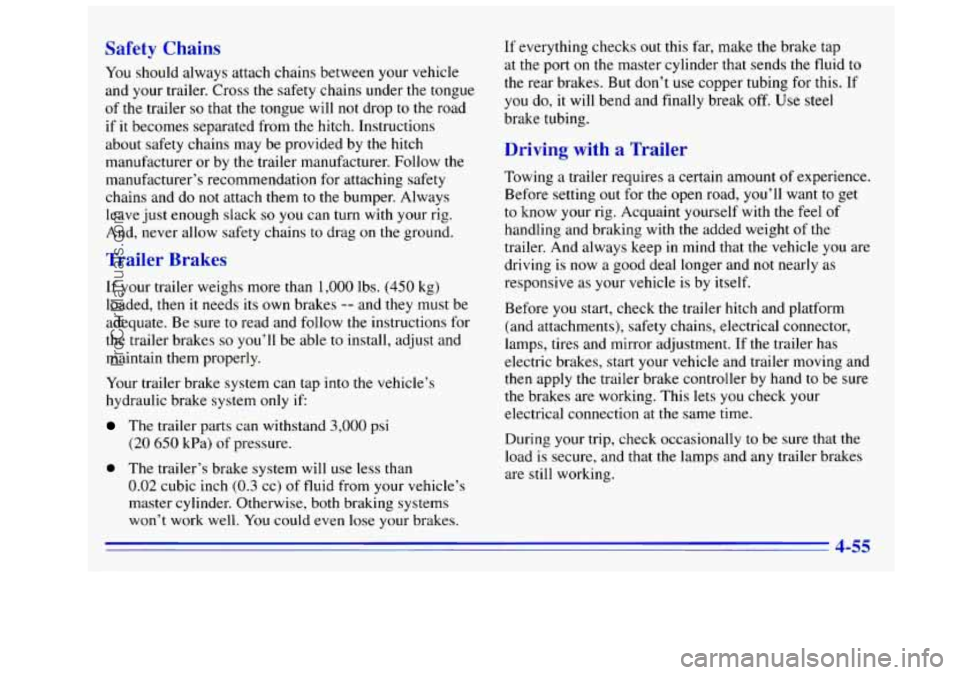
Y
You should always attach chains between your vehicle
and your trailer. Cross
the safety chains under the tongue
of the trailer
so that the tongue will not drop to the road
if
it becomes separated from the hitch. Instructions
about safety chains may be provided by the hitch
manufacturer or by the trailer manufacturer. Follow
the
manufacturer’s recommendation for attaching safety
chains and do
not attach them to the bumper. Always
leave just enough slack
so you can turn with your rig.
And, never allow safety chains to drag on the ground.
If your trarler weighs more than
1,000 lbs. (450 kg)
loaded, then it needs its own brakes
-- and they must be
adequate. Be sure
to read and follow the instructions for
the trailer brakes
so you’ll be able to install, adjust and
maintain them properly.
Your trailer brake system can tap into
the vehicle’s
hydraulic brake system
only if:
The trailer parts can withstand 3,000 psi
(20 650 kPa) of pressure.
0 The trailer’s brake system will use less than
0.02 cubic inch (0.3 cc) of fluid from your vehicle’s
master cylinder. Otherwise, both braking systems
won’t work well. You could even lose your brakes. If
everything checks out this far, make the brake tap
at the port
on the master cylinder that sends the fluid to
the rear brakes. But don’t use copper tubing for this.
If
you do, it will bend and finally break off. Use steel
brake tubing.
rrailer
Towing a trailer requires a certain amount of experience.
Before setting
out for the open road, you’ll want to get
to know your rig. Acquaint yourself with the feel of
handling and braking with the added weight of the
trailer. And always keep in mind that
the vehicle you are
driving is now a good deal longer and
not nearly as
responsive
as your vehicle is by itself.
Before
you start, check the trailer hitch and platform
(and attachments), safety chains, electrical connector,
lamps, tires and mirror adjustment. If the trailer has
electric brakes, start your vehicle and trailer moving and
then apply the trailer brake controller by hand
to be sure
the brakes are working. This lets
you check your
electrical connection at the same time.
During your trip, check occasionally
to be sure that the
load is secure, and that
the lamps and any trailer brakes
are still working.
4-55
ProCarManuals.com
Page 210 of 404
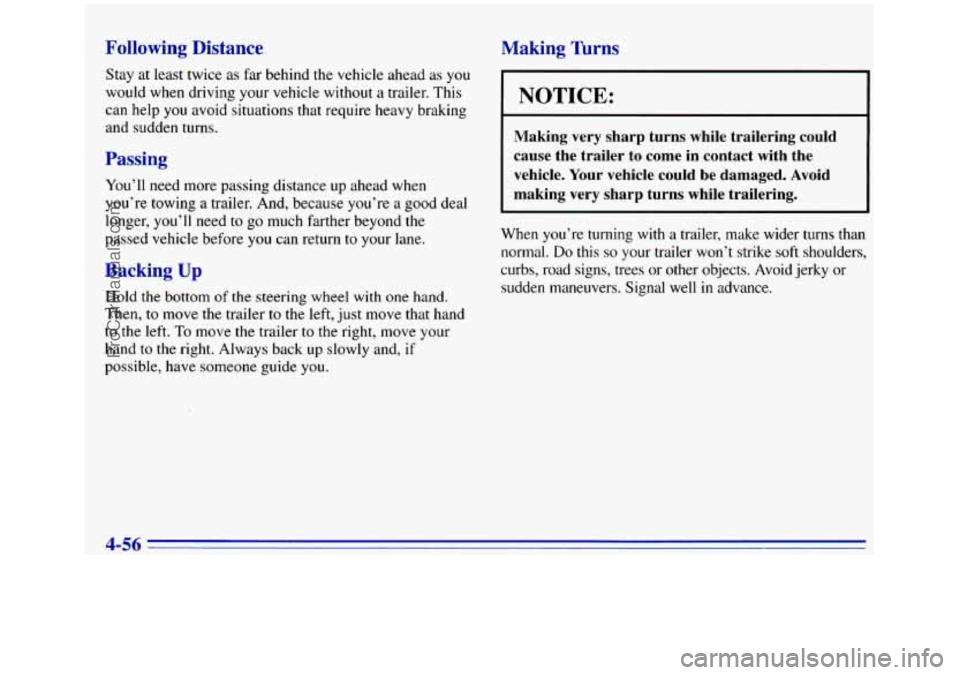
Following Distance
Stay at least twice as far behind the vehicle ahead as you
would when driving your vehicle without a trailer. This
can help
you avoid situations that require heavy braking
and sudden turns.
Passing
You’ll need more passing distance up ahead when
you’re towing
a trailer. And, because you’re a good deal
longer,
you’ll need to go much farther beyond the
passed vehicle before
you can return to your lane.
Backing Up
Hold the bottom of the steering wheel with one hand.
Then, to move the trailer
to the left, just move that hand
to the left.
To move the trailer to the right, move your
hand to the right. Always back up slowlv and.
if
possible, have someone guide you.
Making Turns
NOTICE:
Making very sharp turns while trailering could
cause the trailer to come in contact with the
vehicle. Your vehicle could be damaged. Avoid
making very sharp turns while trailering.
When you’re turning with a trailer, make wider turns than
normal.
Do this so your trailer won’t strike soft shoulders,
curbs, road signs, trees or other objects. Avoid jerky or
sudden maneuvers. Signal well
in advance.
4-56
-
ProCarManuals.com